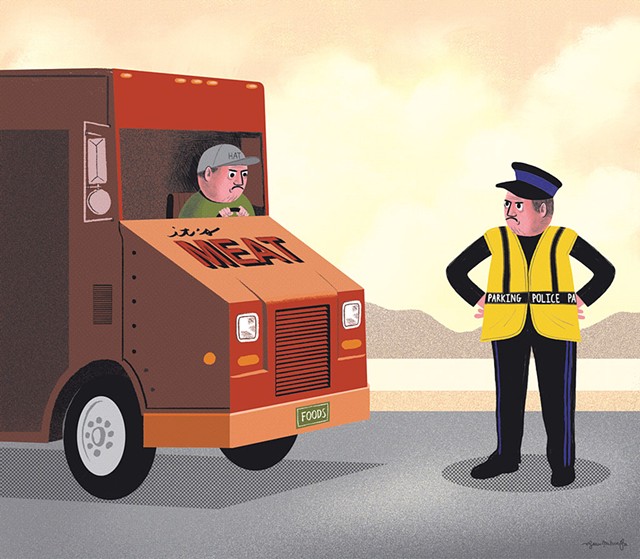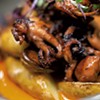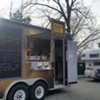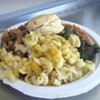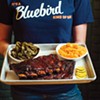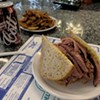Published July 12, 2016 at 1:02 p.m.
For the past two summers, Stefano Cicirello parked his Dolce VT food truck on Pine Street, just north of Howard Street, in Burlington's South End. On weekday afternoons, Cicirello — and other food truckers rotating through the same spot — fed artists and workers from nearby studios and businesses. Many patrons ate at ArtsRiot's picnic tables, a few steps away. On the brick wall behind them, the art space's motto — "Destroy apathy" — made a silent appeal, painted in blocky, black-and-white sans-serif script.
Beside the truck, another sign, issued by the city's Department of Public Works, warned, "1 Hr Parking 8 a.m. to 6 p.m. Except Sundays & Holidays."
If few food truck patrons thought about the nuances of the wall's message over a workday lunch, probably even fewer noticed the parking advisory. Cicirello and the other truckers knew their lunches violated the signage, he said, but no one had stopped them from parking there. Tickets were few and far between.
This spring, ArtsRiot bought its own truck, building on the momentum of its popular restaurant. Chef George Lambertson planned to take over Dolce VT's lunch spot in early summer, once the truck was up and running. He'd serve cheeseburgers and Chinese food, he told Seven Days in June.
But before the truck was ready, city parking officers appeared one day, and they kept coming back. They checked their watches and, exactly one hour later, they'd write Cicirello a ticket. "It was like they were metered spots," Lambertson recalled. "It was really aggressive."
The enforcement put a damper on ArtsRiot's summer plans, but it's also a symptom of a problem that stretches beyond Pine Street: As mobile eats continue to gain popularity, food truckers are struggling to find their place in Burlington's parking-strapped urban ecosystem.
Cicirello has since moved across the street; now he parks near the Maltex Building, where Jamaican Supreme already serves several days a week. Rather than foster competition, having two trucks in close proximity draws more visitors to each, Cicirello said. Meanwhile, ArtsRiot co-owner PJ McHenry is working with the city to remove the time limit on the spot in front of ArtsRiot.
In a phone interview last Thursday, longtime city parking enforcement manager John King denied that Pine Street is the subject of any prioritized ticketing initiative. "It's a violation to [park in front of ArtsRiot] for more than one hour, and we do enforce it," he said. But he confirmed that violations in the area have risen along with the number of cars visiting the South End arts corridor in recent years.
The Squeaky Wheel
While King oversees parking enforcement, Burlington's DPW decides where, when and for how long people can park. Requests to update the ordinances governing parking spots go to engineering technician Damian Roy.
When a request comes in, Roy said, he studies the situation, then passes a report and recommendation to the Public Works Commission, which yeas or nays the request, then submits it for public review. If all goes favorably for ArtsRiot, Lambertson may be able to start cooking in the spot legally by late August.
That's speedy for a government timeline but deadly slow for a fledgling food operation that banks most of its business June through September. "Even if we win the battle, we've really lost the summer," Lambertson said. Roy was "being really reasonable," he added, "but he's trapped in the wheels of the process."
Roy said a large part of that process involves "engaging businesses who are most likely to have patrons use those parking areas."
Dolce VT's Cicirello said Roy told him that one South End business was "against trucks parking on the street."
Which business? "I don't know," Cicirello said. "They wouldn't say."
Reinventing the Wheel
In a phone interview last Friday, Burlington City Councilor Tom Ayres (D-Ward 7) asked a reporter: "Are you aware that within the downtown core, food trucks are not allowed at all?" Ayres chairs the council's license committee and referenced a city statute that prohibits licensing trucks to operate in the area bounded by Cherry, Maple and Pine streets and South Winooski Avenue.
The statute protects "the restaurant district of the community," Ayres said, adding that his "understanding is that [the rule] goes back quite a few years."
Beyond the city core, licensed trucks can theoretically serve food from any unmetered parking spot as long as they respect applicable time limits. But in practice, doing so "gets a little dicey," Ayres said, "because of the interaction with city parking regulations."
Many other American cities have made specific areas available for regular food truck parking. In Burlington, up to seven food trucks are permitted to park along University Place on the University of Vermont's central campus. But none of the five city officials Seven Days spoke with last week could recall how that long-standing arrangement came to be.
Keeping track of the trucks at University Place is a task that falls to Jean Poulin at the Office of the City Clerk/Treasurer. She makes sure each truck is licensed, insured and registered with the city and administers a waiting list of truck owners hoping to join the queue. Provided truckers pay a $400 fee, pass a background check, and submit biometrics and proof of insurance, they can park on University Place at designated times for a year. After that, they can renew for a fee.
Does Poulin think the University Place system could be adapted or applied in other parts of Burlington? "You'd have to go through the license committee [to answer that]," she said, and passed along Ayres' number.
Ayres said he thought the city could "look into creating other areas similar to University Place" in spots where demand for food trucks is high. More specifically, places like Pine Street, he said, where "we've created this food truck culture already."
With ArtsRiot's Friday Truck Stops now in their fourth season, and several trucks already parking in the neighborhood's private lots, facilitating weekday truck access could make sense, Ayres said, particularly as local businesses continue to grow and draw more workers to the area.
"I would be more than happy to put this on the agenda of the next license committee meeting," Ayres added, "and talk with my fellow councilors about what we may be able to do to leverage some progress in that direction."
Though Ayres seemed hopeful that the idea could gain traction, he wouldn't speculate on whether a University Place-type model could work on Pine Street, saying the process would have to begin with amended parking regulations.
Beyond Pine Street, the councilor added, "I think there are probably areas where we could find a little more flexibility for [food truck parking]. I don't think the city is willfully trying to inhibit the growth of food truck culture."
Ayres described an area in Austin, Texas, where "there's a significant stretch of public space that's just one food truck after another." He wished, he noted, that such a place existed in Burlington.
Park Access
Cicirello of Dolce VT has similar ideas for making the city food truck friendly. He suggested "designating some place like Perkins Pier [on the Burlington waterfront] or some other place so we can all set up."
Recent efforts seem to be moving in that direction. In June, Adam Hineman of Taco Truck All Stars — who is working to unite Vermont's mobile food community under the Vermont Food Truck Coalition — teamed up with the city's Department of Parks & Recreation to launch Leddy Park Beach Bites. Ayres, whose Ward 7 comprises an area near Leddy Park in Burlington's New North End, said the first-Wednesday food truck picnics have been very successful. "The city recognizes that we have something significant going on here," he added.
But letting trucks access public spaces is different from allowing them to use public parking spaces. "That's pretty much out of the city council's hands," Ayres said.
At DPW, Roy was lukewarm about applying the University Place model elsewhere in the city. "It's kind of an anomaly," he said, "and we do not consider it to be any kind of precedent we want to expand upon. The general rule is that the right of way is made for access, not enterprise, and using [it for] enterprise is not necessarily the direction we want to go in."
Still, Roy seemed sympathetic to the truckers' predicament. "When this first came up, I started asking myself these questions," he said, "and it got really big really quickly. How do we — or do we want to — manage having trucks on the street? Where should we put it; to what extent? How do we manage it? Do we assign certain trucks to certain areas? Do we shuffle them around? How will they interact with the businesses around them?"
Ensuring that opening the roadway to trucks won't "cause more harm than good" would require extensive research and deliberation, Roy said: "I would think all the major political entities in the city would have to weigh in, all the way up to the mayor's office and city council." Still, he added, "I think it's a worthy discussion to have."
With more trucks trolling the roadways every year — and a robust demand from Queen City workers hungry for lunch-scene diversity — "worthy" could well become "pressing" before too long.
Wondering where to find the latest mobile lunch special?
Since food trucks can be here one day, gone tomorrow and back again somewhere else, Seven Days is compiling a Food Truck Finder. We'll list where and when to find each truck and what to expect when you get there. Find a tasty teaser in the paper each week starting July 20, then check online for expanded info and listings.
Are you a food truck owner who would like to be listed? On the list already, but your schedule has changed? Let us know: [email protected].
The original print version of this article was headlined "Truck Stops Here"
More By This Author
Speaking of...
-

Burlington Budget Deficit Balloons to $13.1 Million
Apr 25, 2024 -

The Café HOT. in Burlington Adds Late-Night Menu
Apr 23, 2024 -

Burlington Mayor Emma Mulvaney-Stanak’s First Term Starts With Major Staffing and Spending Decisions
Apr 17, 2024 -

Totally Transfixed: A Rare Eclipse on a Bluebird Day Dazzled Crowds in Northern Vermont
Apr 10, 2024 -

Middlebury’s Haymaker Bun to Open Second Location in Burlington’s Soda Plant
Apr 9, 2024 - More »
Comments (4)
Showing 1-4 of 4
Comments are closed.
From 2014-2020, Seven Days allowed readers to comment on all stories posted on our website. While we've appreciated the suggestions and insights, right now Seven Days is prioritizing our core mission — producing high-quality, responsible local journalism — over moderating online debates between readers.
To criticize, correct or praise our reporting, please send us a letter to the editor or send us a tip. We’ll check it out and report the results.
Online comments may return when we have better tech tools for managing them. Thanks for reading.


































